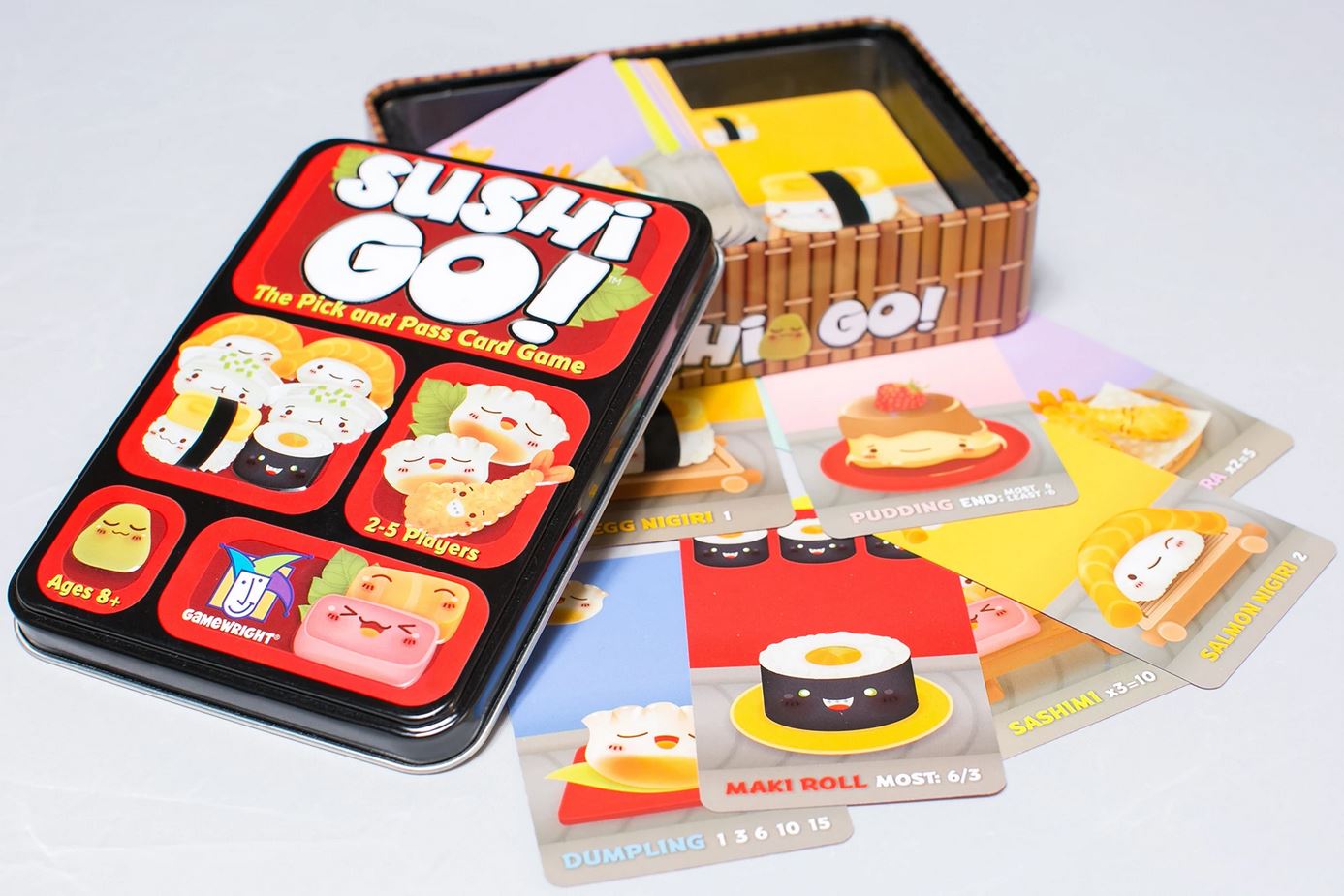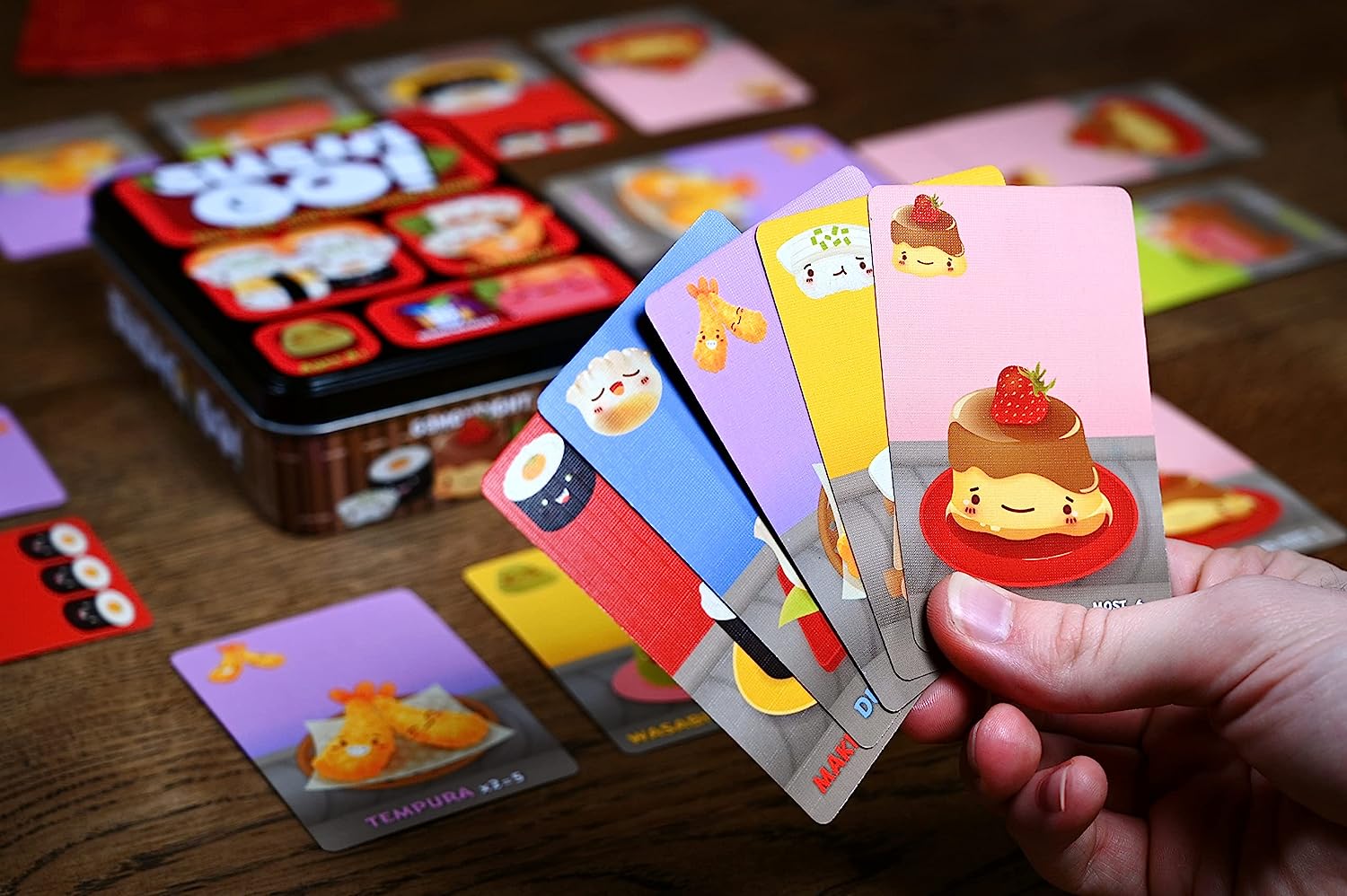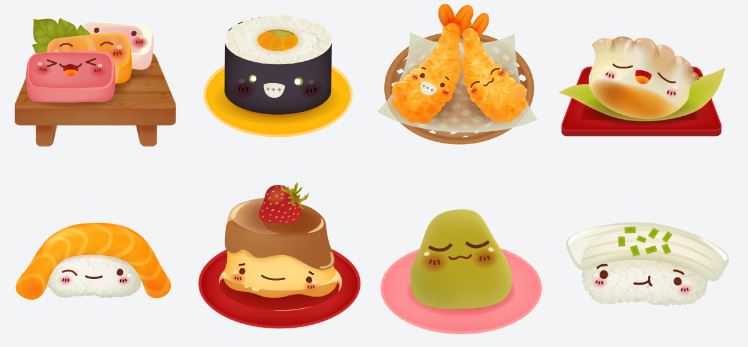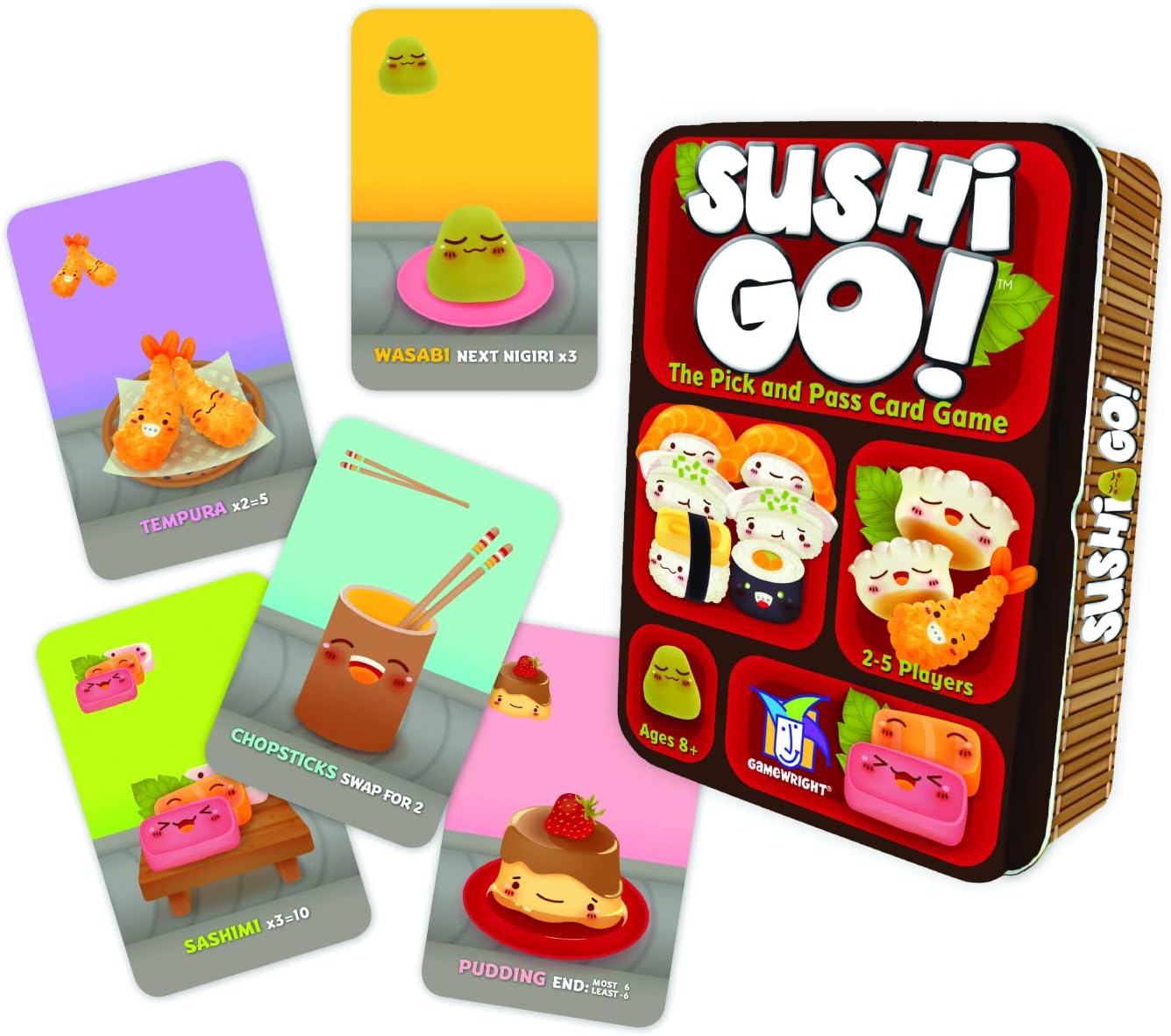Sushi Go! is like a delightful sushi train adventure for your taste buds and your heart. Picture it: you’re at a cozy sushi restaurant with your cute, sushi-loving animal pals. The menu is filled with mouthwatering morsels like sashimi, dumplings, and tempura. But here’s the twist – instead of eating it all, you’re on a mission to create the most adorable and scrumptious sushi combos!
You pick the cutest cards of sushi dishes as they whiz by, trying to complete sets, make mouthwatering pairs, and sneak in some dessert sushi for an extra treat.
The competition is fierce, but the whole game feels like a sushi-themed picnic with friends. So, get ready to become the best sushi chef in town and share the joy of Sushi Go! with family and friends!
What’s included in Sushi Go!

- Sushi Cards: The deck consists of various sushi dishes, each with a unique point value and set-collection rules.
- Menu Tiles: These tiles show the scoring rules for each type of sushi dish.
- Scorepad and Pencils: Used to keep track of players’ scores.
How to play Sushi Go!

Sushi Go! is a fun and fast-paced card game where players draft sushi dishes to create the most delicious combinations and score points.
Setup
- Shuffle the sushi cards and deal a specific number of cards to each player, depending on the number of players (7 cards for 2-5 players, 6 cards for 6-8 players).
- Place the remaining deck face-down in the center as the draw pile.
- Place the Menu Tiles in the center, visible to all players.
Rules for Sushi Go!
Sushi Go! is played over three rounds, and each round consists of the following steps:
1. Pick and Play a Card:
- Simultaneously, all players choose one card from their hand to keep.
- Once everyone has made a selection, reveal your chosen card simultaneously and place it face-down in front of you.
- Pass the remaining hand of cards to the player on your left (in the first round, pass to the right in the second round, and to the left again in the third round).
2. Score Points:
- Check the scoring rules on the Menu Tiles. Score points based on the sushi cards you have collected during the round.
- Some sushi dishes reward points for collecting sets (e.g., tempura, sashimi), while others reward points for having the most of that type (e.g., dumplings, pudding).
- Some cards have special abilities. For example, wasabi triples the value of the next nigiri you play.
3. Discard and Prepare for the Next Round:
- After scoring, discard all played cards (except pudding cards, which remain in front of you for all three rounds).
- Take the remaining hand of cards passed to you, and start a new round.
- Repeat these steps for three rounds, passing cards in different directions each round.
End of the Game: After three rounds, tally up the points from all three rounds. The player with the highest total score wins the game. If multiple players are tied, the player with the most pudding cards is the winner.
Card Types and Scoring

- Nigiri: These are the colorful pieces of sushi. Different types have different point values.
- Wasabi: Triples the point value of the next nigiri card you play.
- Sashimi: Collect three sashimi to earn 10 points.
- Tempura: Collect a pair of tempura to earn 5 points.
- Dumplings: The more dumplings you collect, the more points they are worth.
- Pudding: Collect as many pudding cards as possible over the three rounds. The player with the most pudding cards at the end of the game gets 6 points, while the player with the fewest loses 6 points.
Sushi Go! is easy to learn but offers strategic depth as you anticipate what cards your opponents might play and plan your moves accordingly. It’s a delightful and quick game that’s perfect for both casual gamers and seasoned players looking for a light and fun experience.
For the official rules, see the link below:
Strategies for getting the perfect sushi combo

· Know the Scoring: Familiarize yourself with the scoring rules for each type of sushi card. Understanding how each dish scores points is crucial for making informed choices.
· Balance Your Selections: Try to collect a variety of sushi types rather than focusing exclusively on one. Diversifying your sushi portfolio allows you to adapt to changing circumstances and score points in multiple categories.
· Watch Your Opponents: Pay attention to what your opponents are collecting. If you notice someone heavily investing in a particular type of sushi, consider drafting the cards they need to block their strategy.
· Pudding Prowess: Keep an eye on the pudding cards. Pudding is the only sushi type that accumulates over multiple rounds. Make sure to secure your share of pudding to gain or avoid losing points at the end of the game.
· Combo Synergy: Some sushi combinations offer bonus points. For example, wasabi triples the value of the next nigiri card you play. Look for these combo opportunities and capitalize on them when you can.
· Adapt to Table Dynamics: As the game progresses, the value of certain sushi dishes may change. Be flexible and adjust your strategy based on the cards available and the cards your opponents are playing.
· Manage Your Hand: Don’t be afraid to pass on a high-value card if it doesn’t fit your current strategy. It’s better to let your opponents waste their picks on cards you don’t need.
· Remember the Last Round: In the final round, there won’t be any more card passing. Consider this when making your selections and focus on cards that can stand alone without the support of future picks.
· Timing Is Key: The timing of playing certain cards, like wasabi, can make a big difference. Try to play them at the right moment to maximize their impact.
· Pudding Control: If you’re aiming for the Pudding majority bonus, make sure to count the number of pudding cards in play. If you have the most, you’ll gain points; if you have the fewest, you’ll lose points.
· Play Mind Games: Bluffing and misdirection can be effective strategies. Make your opponents think you’re pursuing one type of sushi while secretly aiming for another.